
Contact

Home
Loch Ness Monster part 4
PERHAPS "THE MONSTER OF LOCH NESS."
The West Australian (Perth, WA)
Date: December 15, 1933
Page Number: 26
A white whale, or Beluga, the type of creature suggested by a British scientist as being the origin ot the Loch Ness (Scotland) "monster"stories. The above specimen is a young, male of a dark slate-grey colour. The adult of the species is white.

1933

continued



SCOTTISH SCARE.
THE MONSTER OF LOCH NESS.
FANTASTIC BEAST.
Cairns Post (Qld.)
Date: December 16, 1933
Page Number: 13
INVERNESS, October 22.
No one is sceptical at Inverness about the existence of the monster which is supposed to inhabit the great 30-mile Loch Ness.
But when l drove to-day along the road which riuns parallel with the Loch for the whole length there was
no trace of its appearance (writes an Inverness journalist on October 22).
Calm and placid were the waters. Not a breath disturbed the glassy appearance of the surface.
In the hamlets and the isolated white cottages; among the road workers in the rough built shacks; and on the farms remote from town or village, I found the monster looked upon with awe and pride.
"Our beastie," he seems to be, and a superstition says that woe will come to the district if any ill befalls him.
He has been talked about for 50 years. He seems to belong to the place. Among the youngsters he is almost a tradition.
One small boy with whom I spoke on the loch side pooh-poohed the idea that it might be an illusion or a large sized conger eel.
"I saw him;" he said proudly, "but only part of him;" he corrected himself. "The part was like a wee boat upturned, all black and scaly," was all he could vouchsafe.
One man who had worked on the roadside for three years admitted he had not seen it himself, but he did not
doubt its existence.
"One night," he informed me, "ten bags of cement were missing from our camp beside the loch. We tell every 'from the south' that the beastie came ashore and ate them."
"NEVER A SIGHT."
One old man I found sitting patiently on the rough boulder-built wall beside the loch near Invermoriston. He was keeping watch and ward for a sight of the monster.
"I've sat here since spring," he confided, "but never a sight ha'e I had o' the beastie."
It appears that while many have seen the beast hardly two accounts agree as to his size or appearance.
One told of how 40ft. of neck had been seen. Another informed me that an English visitor claimed to have seen the saurian walking across the less-frequented road on the west side of the loch carrying a lamb in its mouth back to its lair beneath the waters. In this story it was supposed to look "something like an otter.''
An enterprising Scot prepared a photograph of it on hearing that it had a "head like a horse." He began to sell copies.
Over 12,000 of them went at 2d. each. Then he sold the negative to a picture postcard firm. The cards are selling like wildfire all over Scotland.
I bought one as far away as Fort William, 67 miles from Inverness. One old shopkeeper opened his place furtively on a Sabbath morning to sell me a copy.
SEEN AGAIN.
Finally the creature is said to have been seen last Friday from the canal tug Scott II, which makes the trip from Fort Augustus to lnvarness.
At the part of the loch between Invermoriston and Foyers the tug, which had a barge in tow, was proceeding slowly. Mr. R. McConnel, of Fort Augustus, the engineer, said :
"I first saw the object following in the rear oft he barge. Its huge back was about 2ft. out of the water, though neither head nor tail was showing. It was throwing up a wash as it followed the barge. I called Cameron, the mate, and McKenzie, the fireman, on deck. They both saw the monster. By then it was lower in the water.
"Only about a foot was showing. As we all watched it it sank out of sight."
The crew are in no doubt that was some sort of animal they saw, and the time is recorded as between 9 and 10 a.m. on October 20.
NO ESCAPE?
Some people believe that with the blasting operations, which have been in progress during the last three years to form a canal from the loch to the sea for steamers, the monster may have been disturbed or may have entered the loch and been unable to find an exit. Only if it had the intelligence to follow a boat out when the gates are open could it escape.
The loch-side dwellers, however, have an older belief which amounts to a superstition. To them the monster is a kind of god who must be propitiated by being left in the peaceful seclusion of the waters in whole fathomless depths. He has reigned as monarch as long as time itself.
The fantastic monster said to be 30ft. long and to have eyes like motor car lamps, which manypeople declare they have seen troubling the calm water of Loch Ness, near Inverness, would seem to be a member of a scattered family of queer marine creatures.
At any rate, a beast as strange as it was once seen by thaf famous captain of Atlantic liners, Sir Arthur Rostron who, as Commodore of the Cunard Fleet, retired in 1931, having been 46 years at sea.
"In 1907, when I was chief officer of the Campania and the ship on a Friday was off the coast of Ireland, making for Queenstown, I saw an amazing sea monster," he told a "Daily Mail" reporter on Saturday.
"I first saw it when it was about two miles ahead, and thought that it was probably a a tree trunk. On coming near to it, however, and keeping my glasses trained on it, I saw the thing was alive.
"Its great head was reared about eight feet out of the water, and was darting from, side to side with sudden movements, such as you see a black bird make when it is hunting worms on the lawn. There were two protuberances where eyes might have been, but I could see no eyes.
SMALL EARS.
"Its neck was fully 13 to 14 feet long, and although only part of its body was out of the water , it was plain that the complete length of the monster must have been very great.
"It had very small ears in conpari- son with its enormous bulk.
"When it came within the wash of our propellers it dived rapidly, and presently came to the service again, still moving its head in that queer way. Then it again dived, and again rose. It stayed on the surface for a few minutes longer, and finally submerged and nobody saw it again.
TWO SKETCHES.
"On the following evening when I was in Liverpool, I heard of a man who had been found drifting in a rowing boat in the Britol Channel. This man said that he had lost both his oars and his boat-hook while fighting a terrifying monster in the sea.
His description of the monster tallied in every detail with that of the strange thing I had seen—and here is the fact that when it had disappeared from my sight it had headed to the castward and presuming that it kept
on its course, it would have gone right into the Bristol Channel.
"While I had my eyes on the monster I made two sketches of it on the screen before on the bridge. The third officer of the Campania also saw it.
"There are people who laugh and sneer when they hear talk of the 'sea-serpent,'" Sir Arthur ended, "but I tell, you no one in this world knows what strange creatures live in the depths of the ocean.
"If I who spent 46 years of my life at sea saw in that time only one strange monster, people who have made merely occasional journeys over laugh at the sea-serpent idea because they have never seen anything strange on the sea."

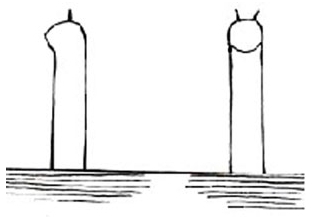
On Rostron’s sketches, these very small ears look like snail’s horns, similar to many descriptions of plesiosaurs and lake and loch
monsters. When the Captain of the Campania heard about the incident, he asked Rostron what he had drunk at dinner. Neither the sketches
nor Birnie's corroboration convinced him. In due course the Campania docked at Liverpool.
After shore leave, the Captain called on
Rostron and raised the matter again. ‘Did you see it, Rostron?’ he asked. ‘Yes Sir,’ replied the religious Rostron.
SOURCE
"His description of the monster tallied in every detail with that of the strange thing I had seen"
If we look up the press reports
however, for instance, the Liverpool Echo of April 30, 1907, it is hard to share Rostron's conviction when it was revealed that a
Mr McNaughton says he was attacked by a monster ‘like a huge mummy with sunken eyes enveloped in a sort of hairy flap.’
He added:
‘The flabby monster seemed to leap out of the water as straight as an arrow for me. I hardly know what I did. I think I must have
ducked and crashed the oar into the creature. At any rate I was flung violently into the water. When I regained the surface I managed
to clamber into the boat. My terrible enemy was nowhere in sight.’
SOURCE
THE LOCH NESS 'MONSTER'
And the Loch's Romantic History
By George Waddell
Sunday Times (Perth, WA)
Date: December 17, 1933
Page Number: 13 S
Just to close the sea serpent season, and for the benefit of "Rip Van Winkle," the existence of the Loch Ness monster now seems to have been established beyond doubt, as it has been seen again by persons from different parts of the loch's banks.
Mr. George MacQueen, an Automobile Scout, who des the patrol work on the Fort Augustus Invermoriston- road, saw the monster opposite Port Clair, travelling at great speed, and to him it resembled an upturned boat. Again, seven people who were having tea at a house at Altish, by the loch side, saw the creature, which appeared to have two bumps on its back.
The stories told have been multiplied and with each telling the monster gets larger, so that no idea of its actual size or appearance has emerged, and the strange creature seems to be timid as it has always avoided appearing near the shore of the loch, which accounts for the lack of a detailed description.
The Duke of Portland has recalled that nearly 40 years ago, when he became tenant, his head forester and others spoke of the great horrible beast in the loch. But the earliest reference to tales of the monster go back to the year 664 when a swimmer was bitten to death by an aquatic creature whereupon St. Columba bade Lugne Mocumin swim across the loch to demonstrate that by an invocation to God he could protect the man.
It is on record that at the voice of the saint the monster was terrified, and fled more quickly than if it had been pulled back with ropes.
This is the earliest record of the monster, which also appeared in 1520, twice between 1600 and 1700, again in 1771 and 1885, and in 1912. Mr. D. Murray Ross makes reference to the monster of Loch Ness from an old book dealing with curiosities such as dragons, dog devils and the dwarfs of Dalton, which would indicate that Scotland at one time had some very dreadful beasts to terrify the people.
Mr. Ross writes of this book: "It mentions that the monster appeared in the year when Fraser of Glenvachkie, after a 'sair tussle' killed a fire-spouting dragon which, during the fight, burnt and flattened the heather over a fabulous extent. It goes on to say that Fraser killed the last known dragon in Scotland. But no one has yet managed to slay the monster of Loch Ness. Fraser's fight with the dragon took place about 1520."
Now as Loch Ness has acquired a weird interest, a few notes will not be out of place. Loch Ness is a stretch of water of an exceptional nature owing to its narrowness and great depth and a large aquatic animal once within its deep waters might find great difficulty in escaping to the sea. From Bona Fury on the north-east, to Fort
Augustus at the south-west, the loch stretches for 22˝ miles with an average breadth of about a mile, and its surface is 50 feet above sea level. Both sides are flanked by lofty hills, which, on the northern side average 1200 to 1500 feet, and on the southem side from 800 to 1000 feet, and the slopes descend so steeply to the water that a short distance from shore 240 to 250 feet can be measured, and in the middle of the loch the depth varies from 636 to 690 feet. On this account the waters of the loch never freeze.
The loch lies on the line of a fault in the earth's crust, and when the great earthquake occurred in Lisbon on November 1, 1755, the whole of the water was violently agitated and waves rolled to the upper end, dashing up the course of the Oich for 200 yards at a level of five feet above the normal. It is a curious fact that whilst salmon must pass through the loch on their way to the Oich, they are never caught with the rod in the loch itself. In fact the fishing is poor, though trout are plentiful.


Rip Van Winkle

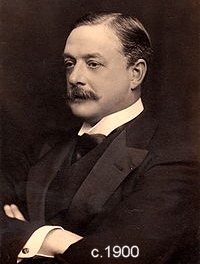

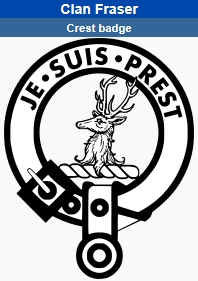
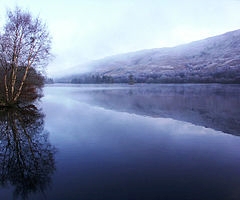

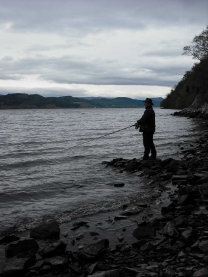

Duke of Portland
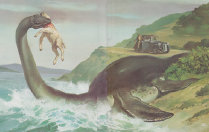
Contents



















